Understanding the foundations of Music Theory in order to create amazing songs is vital for a music producer.
Today we’re going to introduce you to the Circle of Fifths, a powerful tool that can revolutionize your songwriting process.
In this guide, we’ll dive deep into the Circle of Fifths, covering its components, application, and even some unconventional ways to use it in your songwriting.
So, grab your favorite instrument, and let’s get started!
Table of Contents
- The Circle of Fifths: Explained
- Exploring the Circle of Fifths with Key Concepts
- Perfect Fifth Interval
- Sharp Keys and the Circle of Fifths
- Diatonic Scale and the Circle of Fifths
- Adjacent Keys on the Circle of Fifths
- New Key and the Circle of Fifths
- Navigating the Entire Circle
- Musical Key and the Circle of Fifths
- Successive Key and the Circle of Fifths
- Major Third and the Circle of Fifths
- iv Chord and the Circle of Fifths
- Music Theory
- Major Scales & Keys
- Minor Keys and Minor Scales
- Relative Major Keys and Relative Minor Keys
- Key Signatures
- Equal Temperament
- The Chromatic Circle
- Expanding Your Knowledge: Beyond the Circle of Fifths
- The Circle of Fifths and Ear Training
- Circle of Fifths Explained: Additional Keywords You Should Know
- Bonus: 10 Unconventional Ways of Using the Circle of Fifths to Write Songs
- Final Thoughts
The Circle of Fifths: Explained
The Circle of Fifths is a visual representation of the relationship between the 12 tones of the chromatic scale.
It’s called the “Circle of Fifths” because, as you move clockwise around the circle, each key is a perfect fifth apart from its neighbor.
This concept has been around for centuries, dating back to Pythagorean tuning, and has been a cornerstone of Western Music Theory ever since.
By using the Circle of Fifths, you can quickly:
- Identify which chords work well together
- Create smooth modulations
- Come up with entirely new and intriguing chord progressions
Not only will the Circle of Fifths help you understand key signatures and relationships between various keys, but it also serves as a valuable tool for composers and songwriters.
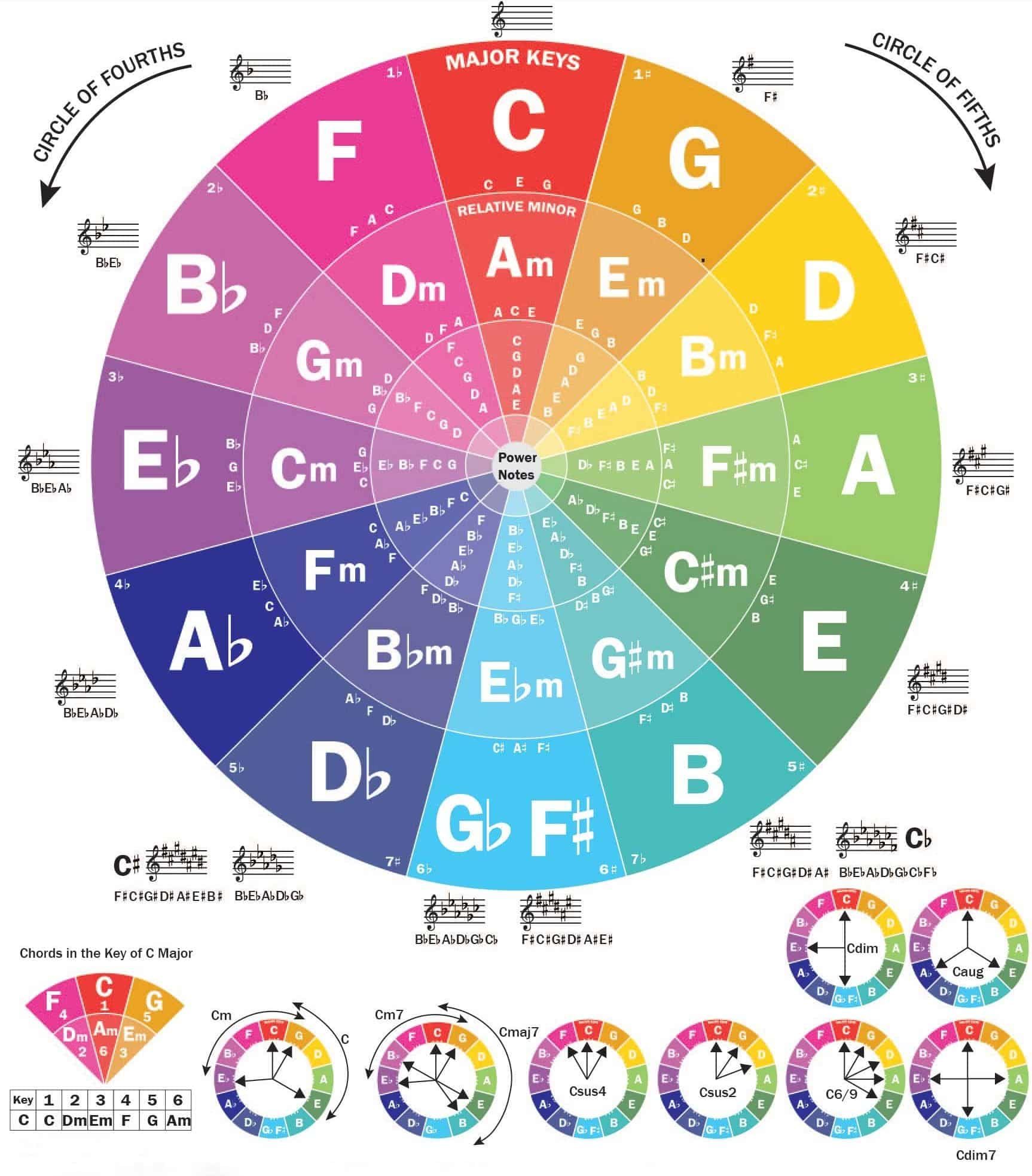
Imagine a clock face, but instead of numbers, you have the 12 pitch classes arranged in a circle:
- C
- C#/Db
- D
- D#/Eb
- E
- F
- F#/Gb
- G
- G#/Ab
- A
- A#/Bb
- B
What The Circle of Fifths does, is places each pitch class a perfect fifth above the previous one, moving clockwise.
So, starting with C at the 12 o’clock position, you’d have G at 1 o’clock, D at 2 o’clock, and so on.
The Circle of Fifths not only shows the relationships between keys but also reveals patterns in key signatures.
For example, as you move clockwise, each key adds a sharp to its key signature.
Conversely, as you move counterclockwise, each key adds a flat.
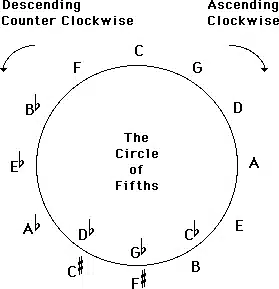
This pattern helps you understand how many sharps or flats are in a given key signature quickly.
Exploring the Circle of Fifths with Key Concepts
-
Perfect Fifth Interval
At the heart of the Circle of Fifths lies the perfect fifth interval.
The perfect fifth is the basis for the circle’s structure, as each successive key is a perfect fifth apart from its neighbor.
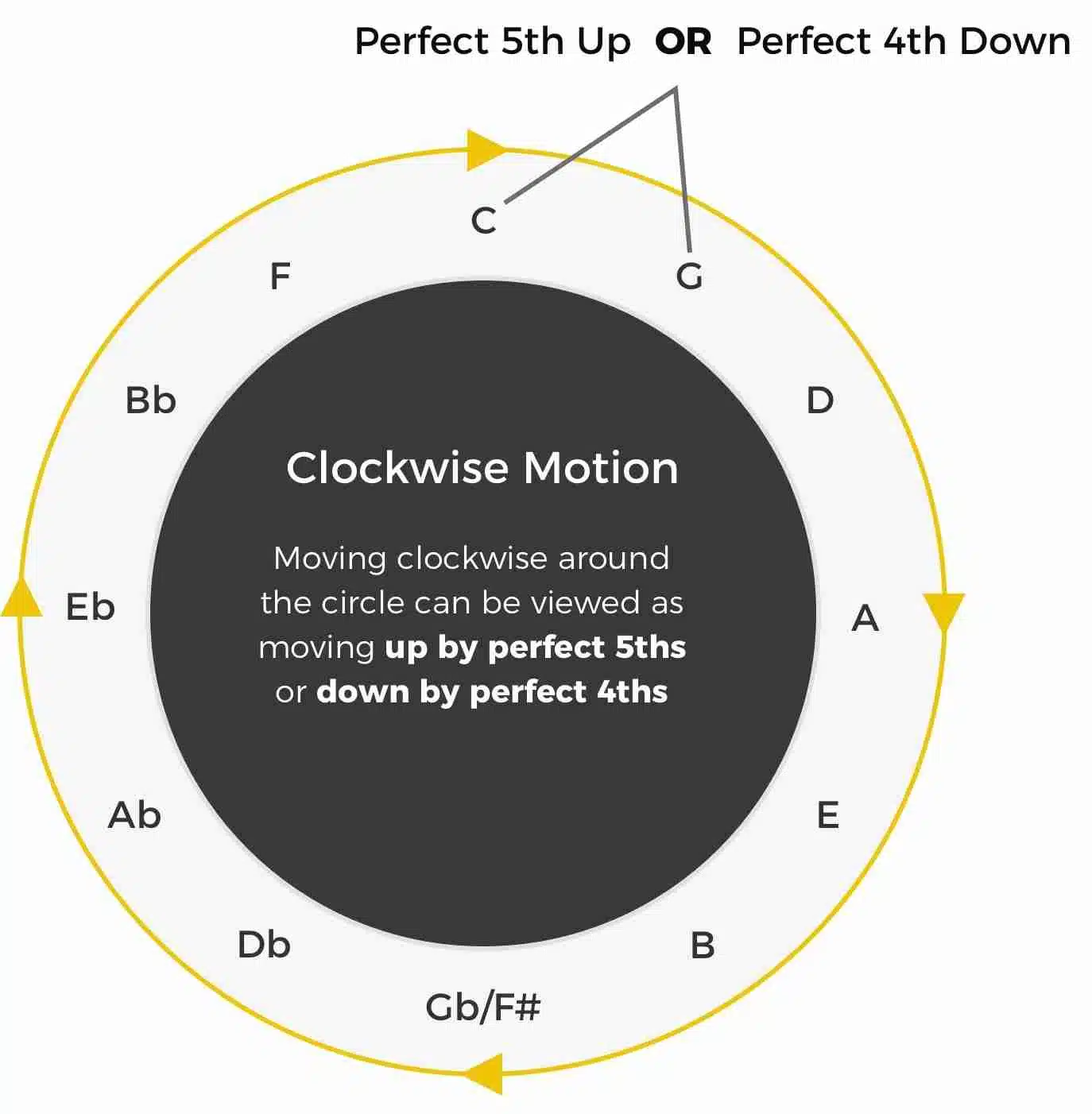
This relationship between keys makes the Circle of Fifths a powerful tool for understanding harmony, key relationships, and advanced chord progressions in Western music.
-
Sharp Keys and the Circle of Fifths
Sharp keys are major keys with one or more sharps in their key signature.
As you move clockwise around the Circle of Fifths, you encounter sharp keys with increasing numbers of sharps in their key signatures.
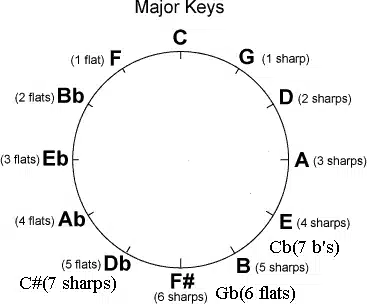
For example, G Major has one sharp (F#), D Major has two sharps (F# and C#), and A Major has three sharps (F#, C#, and G#).
This pattern continues as you progress around the circle, with each sharp key adding one more sharp to its key signature.
-
Diatonic Scale and the Circle of Fifths
The diatonic scale is a seven-note scale that includes five whole steps and two half steps.
Both major and minor scales are types of diatonic scales.
The Circle of Fifths helps you understand the relationships between diatonic scales in dissimilar keys, as well as the key signatures that define them.
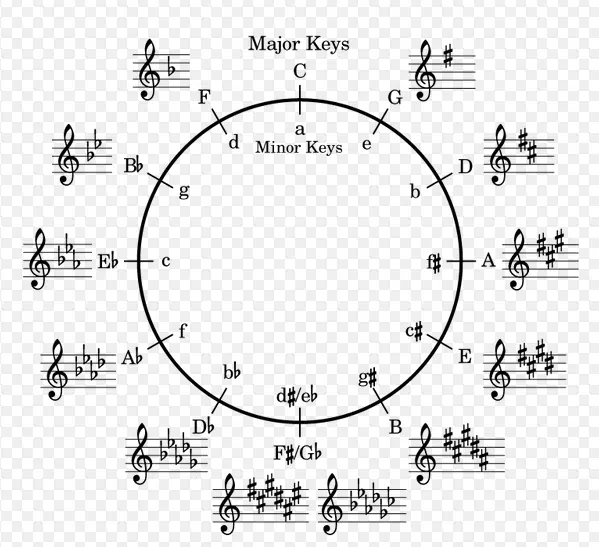
By examining the circle, you can quickly identify the key signature of a specific diatonic scale and understand the relationships between adjacent keys.
-
Adjacent Keys on the Circle of Fifths
Adjacent keys on the Circle of Fifths share a close relationship, as they differ by only one sharp or flat in their key signatures.
This makes it relatively easy to modulate or change from one adjacent key to another, creating a smooth transition in your music.
For example, if you’re in the key of C Major and want to explore a new key, you can move to the key of G Major (with one sharp).
Or, FM (with one flat) by adding or subtracting a single accidental from your key signature.
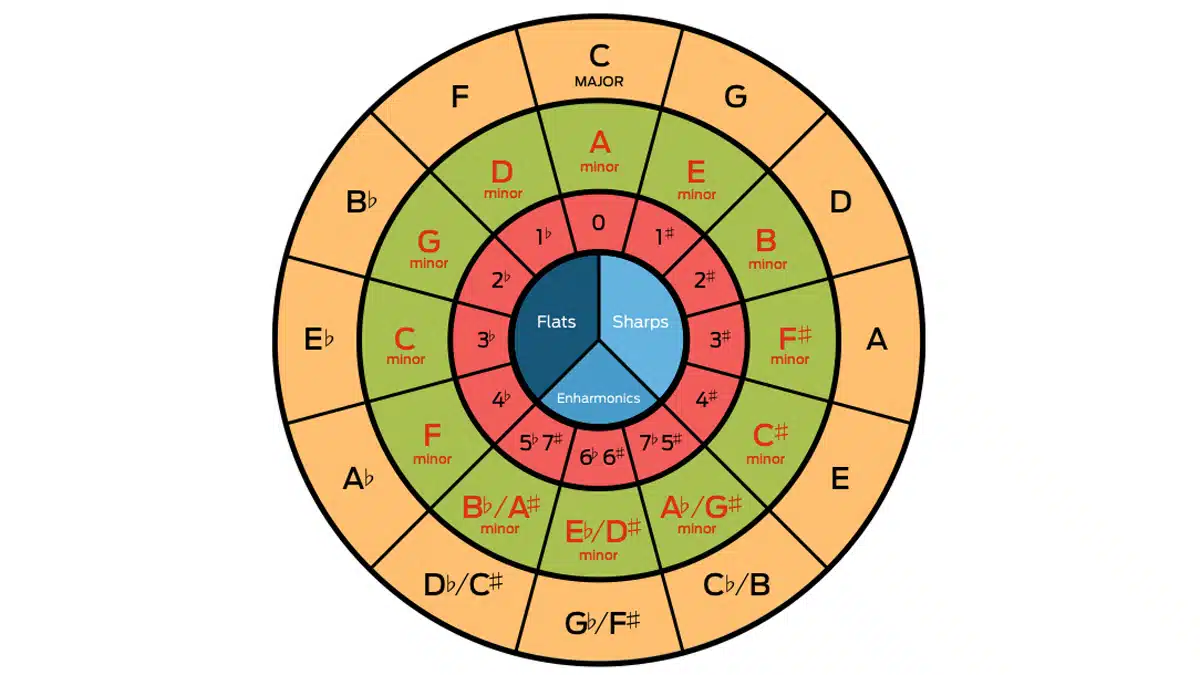
-
New Key and the Circle of Fifths
When you’re looking to modulate or change to a new key in your music, the Circle of Fifths can be a valuable guide.
By examining the relationships between keys on the circle, you can identify potential new keys that share common notes and chords with your current key, making for smoother modulations.
Alternatively, you can also explore more distant key relationships for more dramatic or unexpected key changes, adding variety and interest to your compositions.
As you progress around the entire Circle of Fifths, you’ll cycle through all 12 keys and their relative minor keys.
By familiarizing yourself with the whole circle, you’ll gain a comprehensive understanding of the relationships between all major and minor keys, major chords, and minor chords, as well as their key signatures.
This knowledge can greatly enhance your ability to navigate different musical keys, create interesting modulations, and understand the harmonic structure of the music you’re working with.
-
Musical Key and the Circle of Fifths
The concept of a musical key is central to the Circle of Fifths.
Each key is defined by its tonic or root note and its key signature, which dictates the sharps or flats used in the key’s diatonic.
The Circle of Fifths organizes these keys in a way that highlights their relationships and helps you visualize the structure of each key.
It makes it much easier to work with different varieties of keys in your music.
This is super beneficial for writing songs that you’re imagining in your head already.
-
Successive Key and the Circle of Fifths
The Circle of Fifths also illustrates the concept of successive keys, as each key on the circle is a perfect fifth apart from its neighbor.
By moving through successive keys on the circle, you can create unique chord progressions and modulations.
Or even entire compositions that weave through alternate keys while maintaining a sense of harmonic coherence.
Understanding the relationships between successive keys on the Circle of Fifths can help you create more engaging and dynamic music.
-
Major Third and the Circle of Fifths
A major third is an interval consisting of two whole steps, and it plays a significant role in defining major chords and keys.
While the Circle of Fifths is primarily built on perfect fifth intervals, you can also use it to identify major thirds by jumping over two keys clockwise.
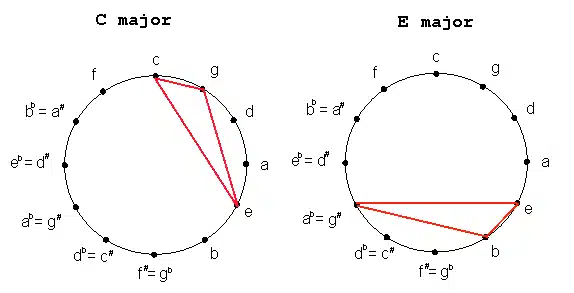
For example, if you start on C Major and move two keys clockwise to E Major, you’ve traversed a major third.
Understanding this relationship on the Circle of Fifths can help you create chord progressions and modulations that involve major thirds, adding harmonic variety to your music.
iv Chord and the Circle of Fifths
The IV chord is the fourth chord in a diatonic scale and plays a crucial role in many chord progressions, particularly the classic I-IV-V progression.
Using the Circle of Fifths, you can easily identify this chord of any key by moving one position counterclockwise from your starting key.
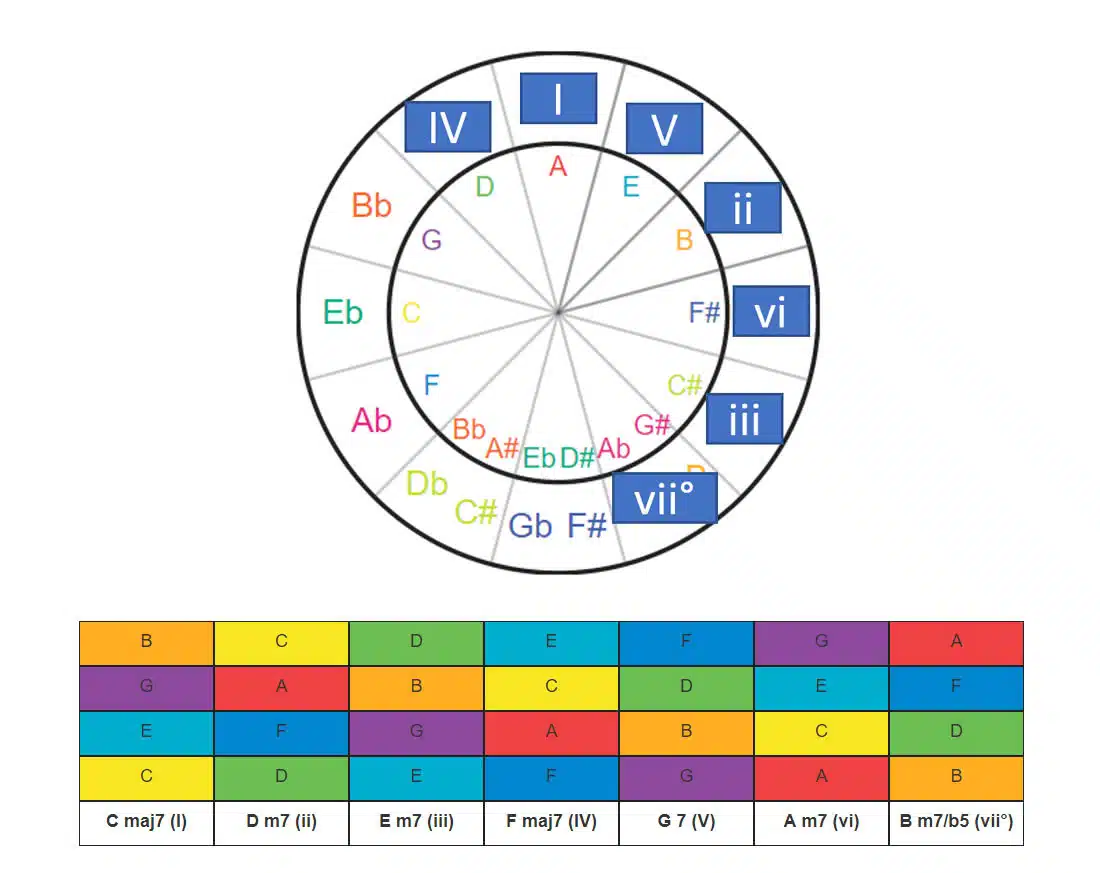
For example, if you’re in the key of C Major, chord IV would be F Major, as F Major is one position counterclockwise from C Major on the Circle of Fifths.
By understanding the relationship between keys and their IV chords on the circle, you can create and analyze chord progressions more effectively.
Music Theory
Music theory is the language of music, and understanding it can make a world of difference in your music production and songwriting.
By learning the rules and conventions of music theory, you can communicate more effectively with other musicians and create more engaging compositions.
You can even break the rules in creative ways to develop your unique sound (discussed further on).
The Circle of Fifths is an essential part of music theory because it illustrates the relationships between different keys and chords.
By understanding how keys are related, you can make informed decisions about chord progressions, modulations, and harmonic structure in your music.
Moreover, the Circle of Fifths is a practical tool that can help you quickly recall key signatures.
This way, if you ever wanted to read and/or write sheet music, it will be a much easier process.
Major Scales & Keys
A major key is a series of notes that follow a specific pattern of whole and half steps, creating a unique sound and emotional quality.
NOTE: A whole step is equivalent to two semitones, and a half-step is equivalent to one semitone.
The major key is often associated with a happy or uplifting mood, making it a common choice for many popular songs.
However, it can also relay other feelings and emotions, depending on how you use it.
Each major key is based on a major scale, which serves as the foundation for the key’s harmony and melody.
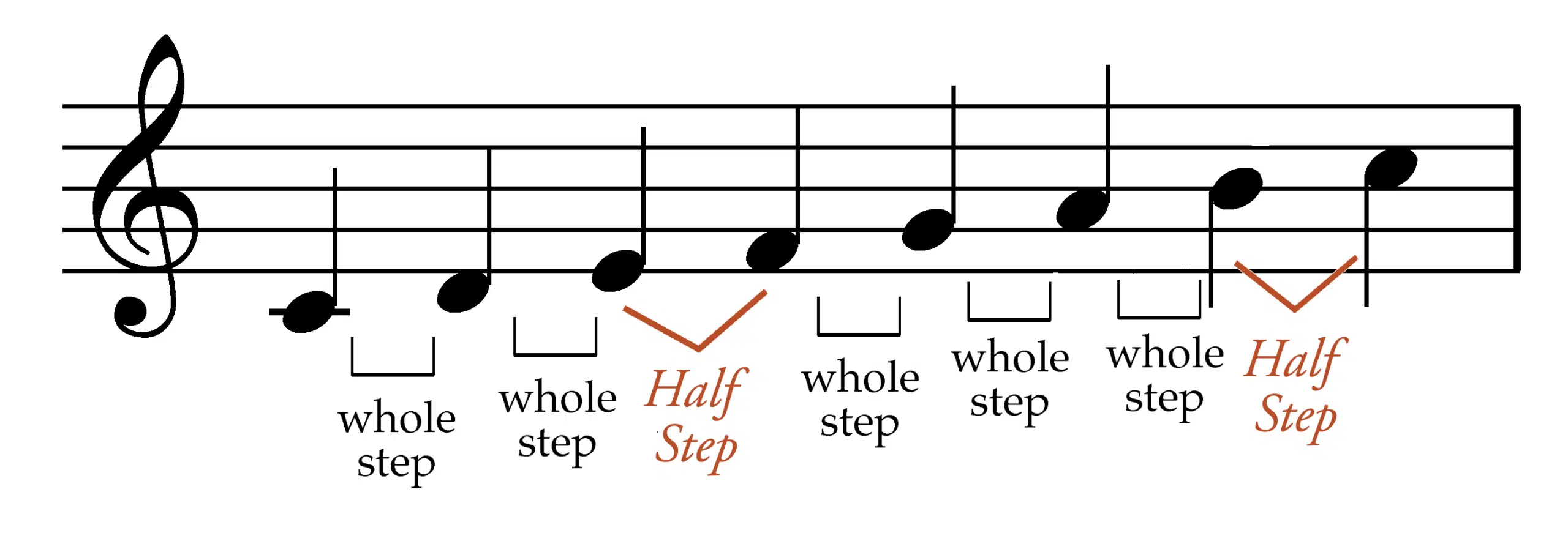
A major scale is a series of seven notes that follow a specific pattern of half and whole steps:
- Whole Step (2 semitones)
- Whole Step (2 semitones)
- Half-Step (1 semitone)
- Whole Step (2 semitones)
- Whole Step (2 semitones)
- Whole Step (2 semitones)
- Half-Step (1 semitone)
The major scale is the foundation for most Western music and serves as the basis for creating chords, melodies, and harmonies within a major key.
Understanding this type of scale is essential for songwriting, as it allows you to create cohesive and harmonically pleasing music.
Using the Circle of Fifths to Identify Major Keys
The Circle of Fifths can help you quickly identify majors and their corresponding signatures.
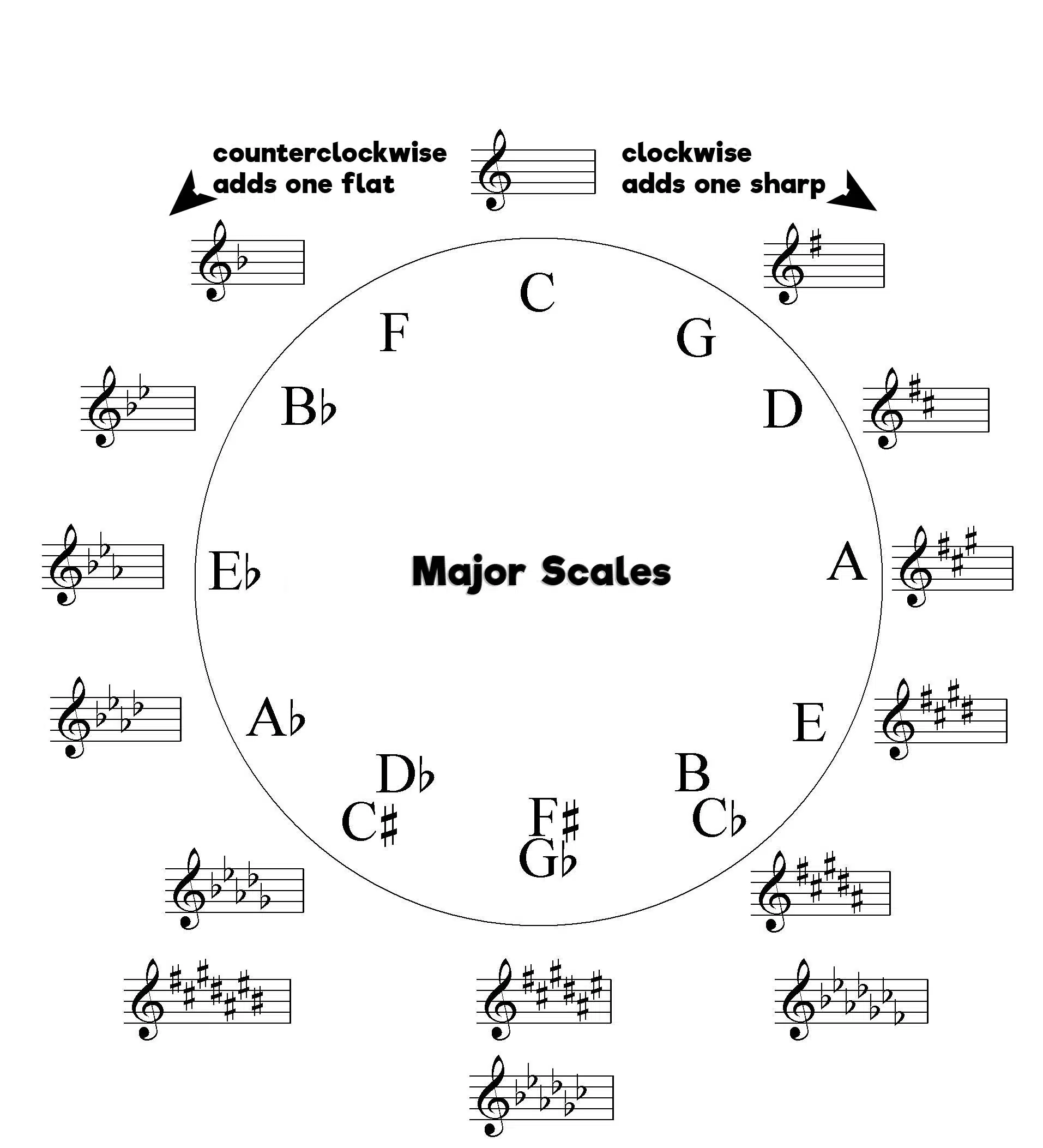
- As you circle clockwise 一 You’ll add one sharp for each step.
- As you circle counterclockwise 一 You’ll add one flat for each step.
For example, starting from C Major at the top of the circle, moving clockwise adds sharps, while moving counterclockwise adds flats to the key signature.
This visual representation makes it easy to determine the number of sharps or flats in a specific major key.
As well as helps you to understand the unique relationships between different majors.
Minor Keys and Minor Scales
A minor key is a series of notes that follow a different pattern of whole and half steps than major keys, resulting in a darker, more somber sound.
Each one is based on a minor scale.
This serves as the foundation for the key’s harmony and melody.
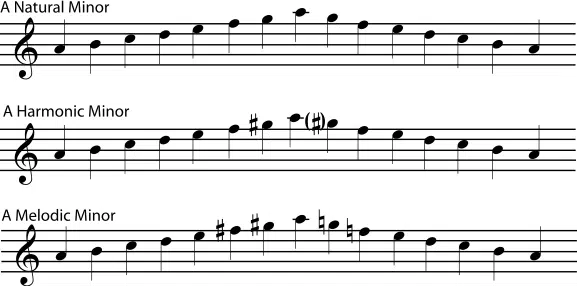
There are three types of minor scales:
- Natural 一 The only minor scale that does not have any altered notes compared to its relative major scale. The notes in a natural minor are the same as those in its relative major, only starting from the sixth degree of the major scale.
- Harmonic 一 Often used to create a distinctive “Eastern” or “exotic” sound in music, as the augmented second interval is not commonly found in Western music scales.
- Melodic 一 Has two different forms: ascending and descending. When ascending, the sixth and seventh notes of the natural minor are raised by a half step, creating a brighter sound. When descending, the melodic minor reverts to the natural minor, lowering the sixth and seventh notes back to their original positions.
The most common type, the natural minor, follows this pattern of whole and half steps: W-H-W-W-H-W-W.
Remember, the “W” represents a whole step, and the “H” represents a half step.
Using the Circle of Fifths to Identify Minor Keys
The Circle of Fifths is also helpful for identifying minor keys and their signatures.
To find the relative minor of a major key, look for the minor key that’s a minor 3rd below the major key.
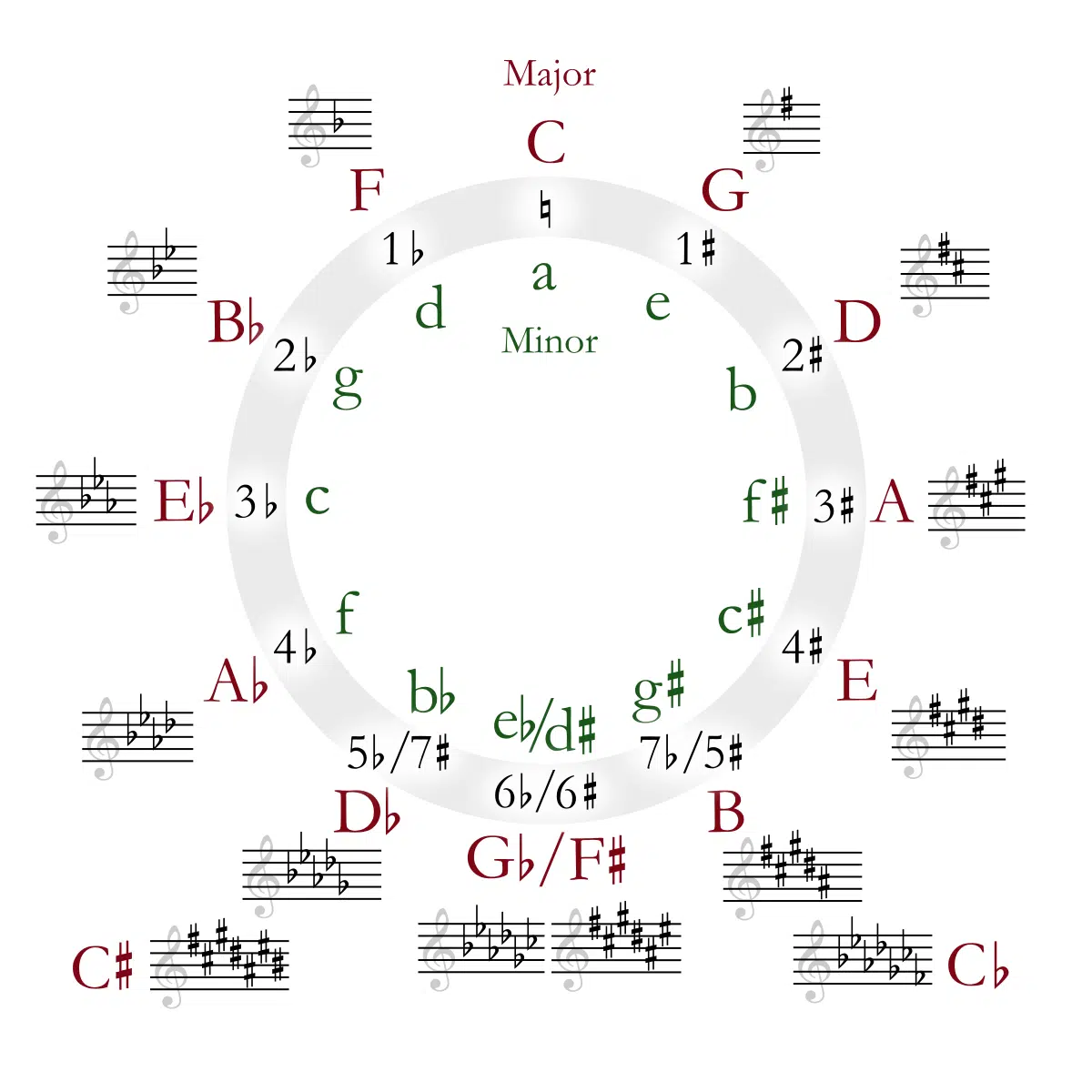
For example, the A Minor chord is a minor third below C Major and shares the same key signature (no sharps or flats).
Like their relative major, minor keys follow the same pattern of adding sharps or flats as you move around the circle.
Moving clockwise around the circle adds sharps, and moving counterclockwise adds flats to the key signature of the minor.
This makes it easy to identify the number of sharps or flats in a specific key and understand the relationships between different minors.
Relative Major Keys and Relative Minor Keys
Relative keys are pairs of major & minor keys that share the same key signature.
Although their tonal centers are different, relative keys have the same collection of notes.
This makes it easy to borrow chords and melodies between them for interesting harmonic and melodic effects.
-
How to Find Relative Majors
Relative majors share the same key signature as their corresponding minors, but they have a different tonal center.
This is what gives them a brighter and more uplifting sound.
Recognizing these keys are crucial for understanding the relationship between major & minor keys on the Circle of Fifths.
To find the relative major key of a minor, use the Circle of Fifths.
Locate the minor key on the circle and move three positions clockwise.
For example, to find the relative major of A Minor, you’d move three positions clockwise to arrive at C Major.
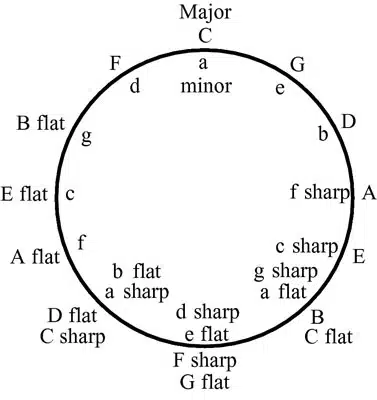
Incorporating relative majors into your songwriting and musical composition can add variety and depth to your music.
It allows you to modulate between majors and minors with the same exact key signature.
This can create dynamic shifts in mood and emotion throughout your songs.
Understanding relative majors can also help you analyze existing music, providing insight into the harmonic structures used by other composers and songwriters.
-
How to Find Relative Minors
Relative minors share the same key signature as their corresponding Maj. keys.
Meaning, they have the same number of sharps or flats.
However, they have a distinct tonal center, which gives them a unique, darker sound compared to their relative majors.
Understanding relative minors is essential for navigating the Circle of Fifths and expanding your harmonic vocabulary.
To find the relative minor of a major key, you can use the Circle of Fifths.
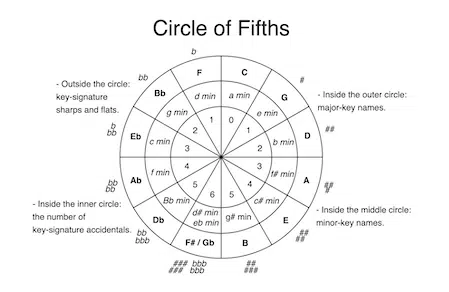
First, locate the major key on the circle.
Then, move three positions counterclockwise.
The key in that position is the relative minor key.
For example, to find the relative minor key of C Major, you’d move three positions counterclockwise to arrive at A Minor.
-
Examples of Relative Keys in the Circle of Fifths
Using the Circle of Fifths, you can easily identify relative key pairs:
- C Major and A Minor 一 Sharing the same key signature (no sharps or flats), the C Major and A Minor keys are a popular choice for many songwriters due to their simplicity.
- G Major and E Minor 一 With one sharp (F#) in their key signature, these keys are often used in guitar-driven music, as they fit well on the instrument.
- F Major and D Minor 一 Sharing a key signature with one flat (Bb), these keys have a slightly darker sound than their neighboring keys, C Major and A Minor.
Key Signatures
A key signature is a set of sharps or flats that indicate the key of a piece of music.
Key signatures are notated at the beginning of a staff, right after the clef, and apply to all notes of the same letter name throughout the piece.
They can help you quickly understand which notes to play and which notes will sound horrible if played.
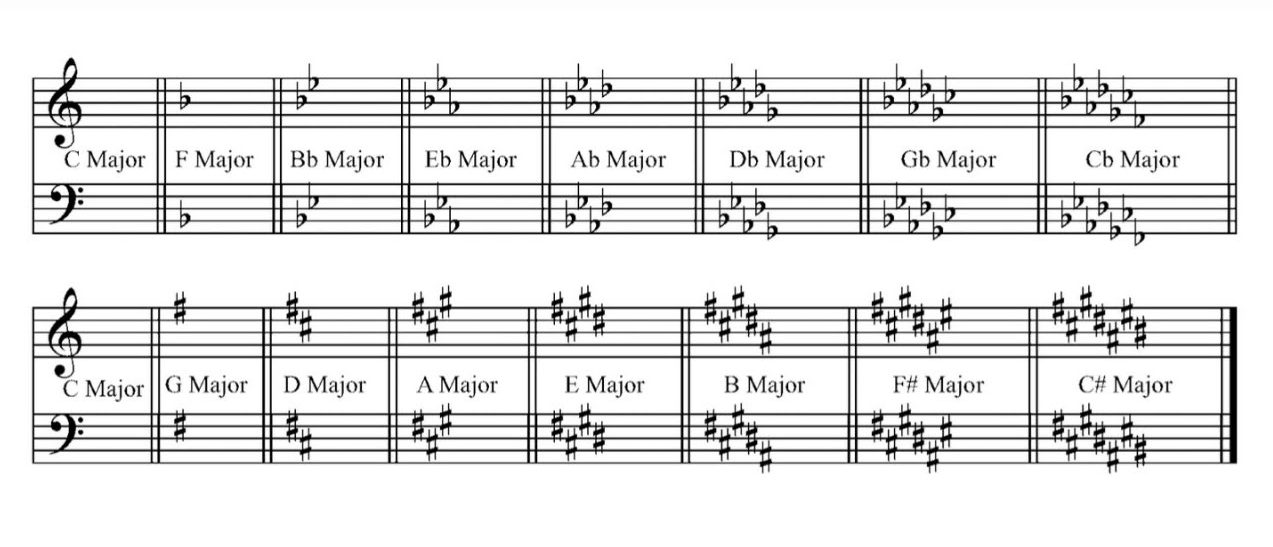
Key signatures are vital in music because they provide essential information about the harmonic structure of a piece.
By indicating the key, key signatures help musicians understand which chords and scales to use when performing or improvising.
Additionally, signatures can affect the emotional quality of a piece, as different keys can evoke different moods and feelings.
Using the Circle of Fifths to Understand Key Signatures
As you move around the circle, you can quickly see how many sharps or flats are in a given key.
For example, the key signature of E Major (four sharps) is located directly to the right of C Major (no sharps or flats).
While the key signature of Bb Major (two flats) is located directly to the left.
This pattern makes it easy to recall signatures and identify which notes are sharp or flat in a given key.
Equal Temperament
Equal temperament is a tuning system in which all 12 notes of the chromatic scale are evenly spaced.
The frequency ratio between each consecutive note is the same.
This system allows for greater flexibility when modulating between keys, as it ensures that all keys sound equal in tune.
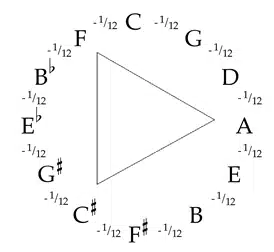
Equal temperament is crucial in modern music because it enables composers and performers to use a wide range of keys and modulations without worrying about intonation issues.
This freedom allows for greater creativity and experimentation in music composition and performance.
Moreover, equal temperament ensures that music played on different instruments or by different performers will sound rhythmically ideal.
The Chromatic Circle
The chromatic is a circular representation of the 12 notes of the chromatic scale (CS), showing the relationship between these notes.
Like the Circle of Fifths, the chromatic is a helpful visual tool for understanding music theory concepts and the structure of the CS.

The Chromatic can also be used as a tool to visualize and understand enharmonic equivalents.
Enharmonic keys are notes that sound the same but have different names, such as C#/Db or F#/Gb.
By examining the Chromatic, you can easily identify enharmonic equivalents and understand their relationship within the CS.
This can be particularly helpful when working with different keys, transposing, or writing music for instruments that use different transpositions or notations.
Using the Chromatic To Create a Chord Progression
While the Circle of Fifths is generally more useful for crafting diatonic chords, the chromatic can be helpful for creating a chord progression that features chromatic movement or borrowed chords.
By identifying the chromatic relationships between chords, you can craft unique and interesting chord progressions that defy traditional diatonic harmony.
Expanding Your Knowledge: Beyond the Circle of Fifths
Once you’re comfortable with the Circle of Fifths, there are many other advanced theory concepts to explore.
Some of these concepts include:
- Modes 一 Dive into the world of modal scales, learning how different modes can evoke unique emotions and textures in your music.
- Extended chords 一 Enhance your harmonic vocabulary by learning about extended chords, including the 9th, 11th, and 13th chords.
- Reharmonization 一 Develop a deeper understanding of harmony by studying reharmonization techniques, which can transform the emotional impact of a melody.
- Polytonality and bitonality 一 Explore the concept of using multiple tonal centers simultaneously in your music.
As your knowledge grows, you’ll develop a more extensive vocabulary to draw from when composing or producing music.
Advanced Theory concepts can also be applied to your music production process, helping you create more intricate arrangements, dynamic mixes, and innovative Sound Design.
By understanding the fundamental building blocks of music, you can manipulate these elements to create unique and engaging productions.
Practice Music Theory Daily
To truly internalize Theory concepts like the Circle of Fifths, it’s essential that you practice regularly.
Set aside time each day to work through exercises, analyze songs, or compose your own music using the concepts you’ve learned.
The more you practice, the more intuitive Theory will become, allowing you to apply it seamlessly in your songwriting and production.
The cliche “practice makes perfect” is a cliche for a reason.
Remember, it takes 10,000 hours to become a professional in something.
You can even try searching for music theory textbooks or courses online.
The Circle of Fifths and Ear Training
Ear training is the process of developing your ability to recognize and identify musical elements by ear, such as intervals, chords, and scales.
This skill is essential for any musician or producer, as it allows you to understand and remix the music you hear, improvise more effectively, and communicate your musical ideas to others.
Understanding the Circle of Fifths can also help you develop your ability to recognize key centers by ear.
Practicing Ear Training with the Circle of Fifths
Incorporate the Circle of Fifths into your ear training practice by using it as a visual reference while you work on recognizing intervals, chords, and key centers.
You can also create your own ear training exercises based on the circle, such as:
- Singing or playing the notes in a specific key
- Practicing interval recognition with the circle as a guide
- Seeing if you can identify a song’s key simply by listening
As you become more familiar with the sound of similar keys and their relationships on the circle, you’ll be better equipped to identify the key of a piece of music simply by listening to it.
How cool would that be?
Circle of Fifths Explained: Additional Keywords You Should Know
1. Major Third Interval 一 The major 3rd interval, consisting of two whole steps, is essential in forming major chords and is easily identified by moving two keys clockwise from a starting key.

2. Major Triad 一 A major triad is a three-note chord comprising a root note, a major 3rd, and a perfect fifth. The Fifths Circle can help you visualize these intervals and understand the relationships between major triads in different keys.
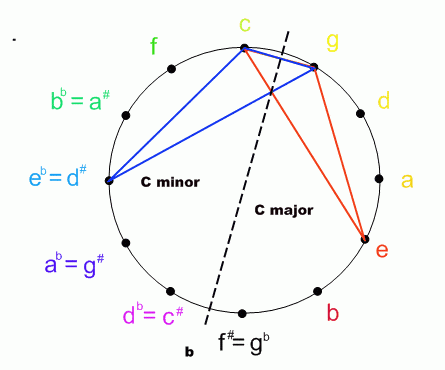
3. Fifths Progression and Perfect Fifths 一 The fifths progression is a chord progression in which each successive chord is perfect fifths apart. This progression is common in many musical styles and is easily identified and analyzed using the Circle of Fifths.
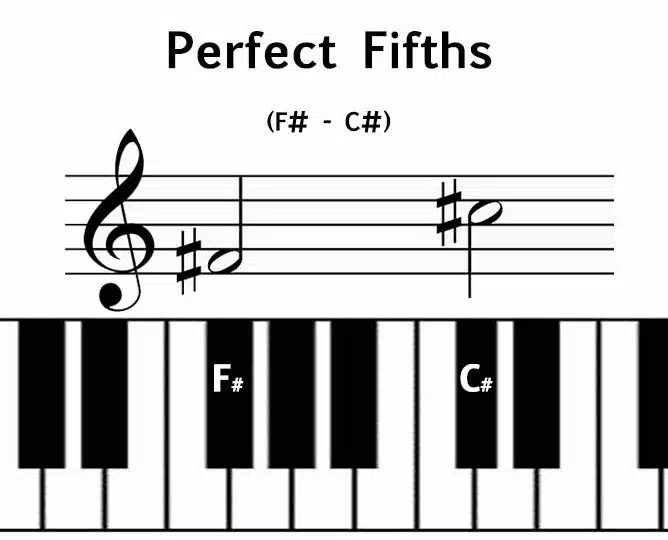
4. Dominant Chord 一 The dominant chord, or V chord, is the fifth chord in a diatonic and is a key element in any common chord progression. By using the Circle of Fifths, you can easily locate the dominant of any key by moving one position clockwise from your starting key.

5. Scale Degree 一 Scale degrees are the individual notes of a diatonic, numbered according to their position within the scale. The Circle of Fifths can help you understand the relationships between a scale degree in different keys and how they relate to the key’s tonic, dominant, and other important chords.

6. Non-Equal Tuning Systems 一 While the Circle of Fifths is based on the equal temperament tuning system used in modern music, it can also provide insights into non-equal tuning systems, such as just intonation, Pythagorean tuning, or meantone temperament. By examining how different keys and notes interact in these systems, you can gain a deeper understanding of the different ways music can be organized and explore the unique harmonic characteristics that each tuning system offers.

Bonus: 10 Unconventional Ways of Using the Circle of Fifths to Write Songs
- Modulate to distant keys 一 Find keys that are far apart and create unexpected modulations for a more adventurous sound.
- Create non-diatonic progressions 一 Experiment with borrowing chords from other keys on the Circle of Fifths for fresh, unique progressions.
- Build complex melodies 一 Outline a melody by moving in fifths or fourths instead of the traditional stepwise motion.
- Explore chromatic mediants 一 Locate keys with a chromatic mediant relationship (major or minor third apart) and create intriguing harmonic shifts.
- Develop modal interchange 一 Borrow chords from parallel modes using the Circle of Fifths to add color and depth to your progressions.
- Use secondary dominants 一 Identify secondary dominants, which can add tension and interest to your progressions.
- Experiment with negative harmony 一 Invert the Circle of Fifths and explore the concept of negative harmony to create new harmonic possibilities.
- Write a circle progression 一 Compose a chord progression that follows the Circle of Fifths, moving through each key sequentially.
- Use the circle for rhythmic ideas 一 Apply the structure of the Circle of Fifths to rhythmic patterns, creating syncopated grooves or polyrhythms.
- Generate unconventional song structures 一 Use the Circle of Fifths as a map to create unique song forms, moving between sections based on key relationships. Start with C Major.
Final Thoughts
The Circle of Fifths is a powerful tool for any music producer or songwriter.
By understanding its components and applications, you can unlock new creative possibilities, enhance your harmonic understanding, and take your music to the next level.
Whether you’re a seasoned pro or just starting, incorporating the Circle of Fifths into your workflow will undoubtedly elevate your songwriting and music production skills.
So, go ahead and explore the Circle of Fifths – the possibilities are truly endless!
To experiment with the highest quality scales, chord progressions, and melodies available today, we have the perfect jumping-off points.
Inside the FREE Unison Advanced Scales MIDI Essentials pack, you’ll find 24 unique, impressive MIDI scales, chord progressions, and melodies.
All of these were created by top sound designers who have mastered the art of Theory, so you can simply plug and play in order to enhance your skills.
Remember to experiment, as that’s what can set you apart from other musicians and help you truly shine.
Until next time…







Leave a Reply
You must belogged in to post a comment.